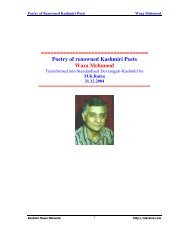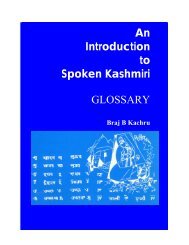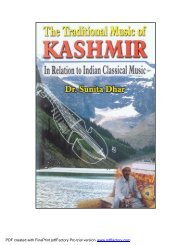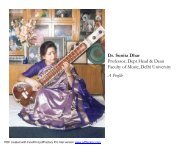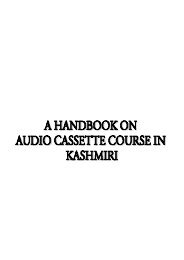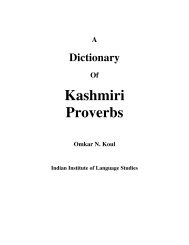Introductory Pages - An Introduction to Spoken Kashmiri
Introductory Pages - An Introduction to Spoken Kashmiri
Introductory Pages - An Introduction to Spoken Kashmiri
You also want an ePaper? Increase the reach of your titles
YUMPU automatically turns print PDFs into web optimized ePapers that Google loves.
<strong>An</strong> <strong>Introduction</strong> <strong>to</strong> <strong>Spoken</strong> <strong>Kashmiri</strong><br />
by Braj B. Kachru<br />
before homorganic s<strong>to</strong>ps in medial and final positions, e.g., lag ‘thigh’ and rog ‘clove’. In<br />
phonological descriptions, the is treated as an allophone of the /n/ which occurs before velar<br />
s<strong>to</strong>ps. The palatal nasal is treated as a combination of n + palatalization. This seems desirable<br />
since almost all consonants have a palatalized counterpart. We shall, however, discuss m, n,<br />
and below.<br />
The m is a bilabial nasal, produced as the m is in the English man or in the Hindi-Urdu ma:ma:<br />
‘mother’s brother’. The n is an alveolar nasal. It is produced as the English n is in now; in the<br />
<strong>Kashmiri</strong> n, however, the <strong>to</strong>ngue is pressed against the upper teeth. It is also similar <strong>to</strong> the Hindi-<br />
Urdu n, as in na:ta ‘short-sized’. The velar is produced by the back of the <strong>to</strong>ngue <strong>to</strong>uching the<br />
soft palate. It is similar <strong>to</strong> the English ng in sing or ring, or the Hindi-Urdu rag ‘color’ or sag<br />
‘in company with’.<br />
Fricatives<br />
m ma:m mother’s brother<br />
lamun <strong>to</strong> pull<br />
k?:m work<br />
mal dirt<br />
n nas nose<br />
pa:n body<br />
nalk0 water tap<br />
na:rj;i:l coconut<br />
na:r fire<br />
pan thread<br />
bag0 Indian hemp<br />
lag thigh<br />
dag style<br />
meg temple (part of thebody)<br />
rog clove<br />
magun <strong>to</strong> ask, <strong>to</strong> demand<br />
logun a traditional wooden pot used for measuring food items.<br />
In the production of fricatives, air passes out through a narrow passage formed by a constriction<br />
in the vocal tract which produces the friction. In <strong>Kashmiri</strong>, there are four fricatives. Three of<br />
these s, s;, and h, are voiceless; the fourth, z is voiced. These sounds are similar <strong>to</strong> those in the<br />
following Hindi-Urdu words: sa:th ‘with’, s;a:m ‘evening’, ha:th ‘hand’, and za:lim ‘cruel’. The<br />
initial sounds in the English words son, shock, hand and zebra are also similar <strong>to</strong> <strong>Kashmiri</strong> s, s;, h<br />
and z respectively.<br />
© 2006 Braj B. Kachru (http://kachru.com) 18<br />
http://koshur.org/<strong>Spoken</strong><strong>Kashmiri</strong>



